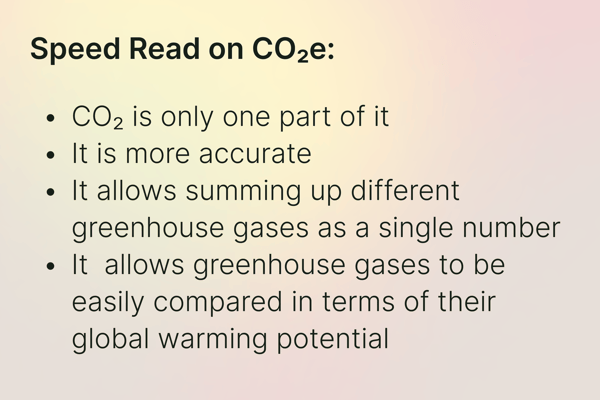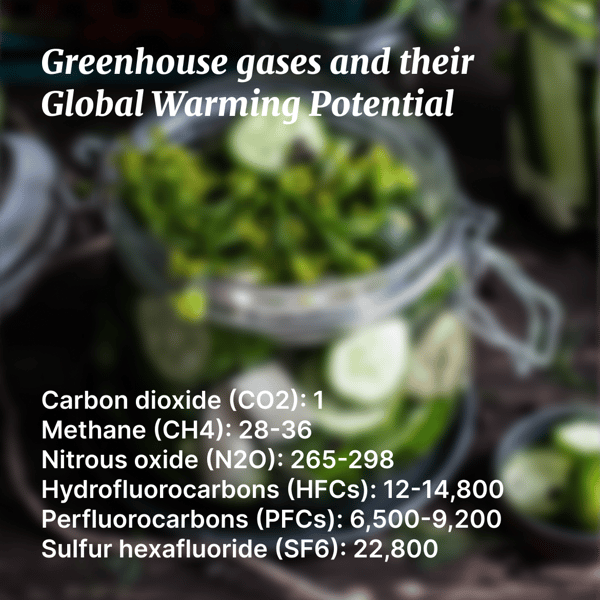Carbon dioxide (CO₂) is one of the naturally occurring gas in the Earth's atmosphere and is also produced by human activities such as burning fossil fuels, deforestation, and industrial processes.
CO₂e stands for carbon dioxide equivalent, which is a metric used to compare the global warming potential of different greenhouse gases. It is a measure of how much of a specific greenhouse gas would have the same warming effect as a certain amount of carbon dioxide. For example, methane (CH4) has a much higher global warming potential than CO₂, meaning that it has a much greater warming effect per unit of gas emitted.
Other examples of greenhouse gases include nitrous oxide (N2O), hydrofluorocarbons (HFCs), perfluorocarbons (PFCs), and sulfur hexafluoride (SF6). N2O is emitted from agricultural practices such as the use of synthetic fertilizers and livestock manure. HFCs are used as refrigerants and air conditioning fluids, while PFCs are used in the production of semiconductors and as solvents. SF6 is used as an electrical insulator in high-voltage equipment.

Global warming potential (GWP) is a measure of how much heat a greenhouse gas traps in the atmosphere relative to CO₂ over a certain time period, usually 100 years. The GWP of a greenhouse gas takes into account the radiative forcing and the atmospheric lifetime of the gas. A higher GWP value means that a gas has a greater warming effect compared to CO₂ over the given time period.
To calculate CO₂e, the amount of emissions of a specific greenhouse gas is multiplied by its GWP. For example, if a factory emits 10 metric tons of methane, which has a GWP of 28 over a 100-year timescale, the CO₂e emissions would be 280 metric tons (10 x 28).
Another example is calculating the CO₂e emissions from electricity consumption. If a household uses 500 kilowatt-hours (kWh) of electricity in a month and the emission factor for the local electricity grid is 0.5 kg CO₂e/kWh, then the CO₂e emissions for that household for that month would be 250 kg (500 kWh x 0.5 kg CO₂e/kWh).

It's worth noting that the GWP values can vary depending on the time horizon being considered (e.g. 20-year or 500-year), and different sources may provide slightly different values basead on their methodology and assumptions. Nonetheless, the above table provides a general sense of the relative impact of different greenhouse gases on global warming.
CO2 (carbon dioxide) is the most relevant greenhouse gas because it is the most abundant and long-lasting greenhouse gas emitted by human activities. It has a long atmospheric lifetime, meaning that once it is released into the atmosphere, it can persist for hundreds of years. Additionally, carbon dioxide has a high global warming potential, meaning that it traps more heat in the Earth's atmosphere compared to other greenhouse gases. While other greenhouse gases such as methane and nitrous oxide have higher warming potentials than CO2, they are present in much lower concentrations in the atmosphere and have shorter atmospheric lifetimes. Therefore, reducing CO2 emissions is crucial to addressing climate change and limiting global warming. Therefore, that’s the term we commonly us to address the climate issues.
The aim behind the unit CO₂e is more transparency. Only through unifying, CO₂e footprints can be compared to each other, because all factors are taken into account. For this reason, you will only find CO₂e values in our app.

Understanding which values sum up to CO2e and the difference to CO2 is quite significant, don't you think? Share the knowledge with your climate aware friends:


